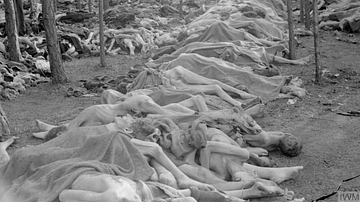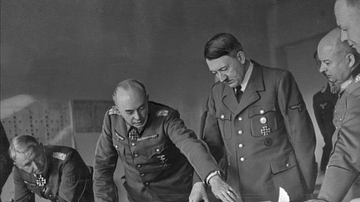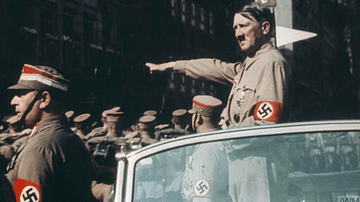The leader of Nazi Germany Adolf Hitler (1889-1945) identified Jewish people as enemies of the state, presenting them through relentless propaganda as responsible for Germany's economic and cultural decline. Basing this propaganda on White supremacist race theory, Hitler was able to use it, along with other populist positions, to increase support for the Nazi Party. Much more significantly, after establishing a dictatorship, Hitler used Nazi anti-Semitism and race theory to present the Second World War (1939-45) as a struggle for Germany's survival against a global Jewish conspiracy and to justify, in his view, the extermination of millions of European Jews in the Holocaust genocide.
From 1933, the Nazis orchestrated a series of measures against Jewish people. Jewish wealth and businesses were appropriated. Those identified as Jews were deprived of citizenship and other rights, encouraged or forced to emigrate, made to wear identifying badges, rounded up into ghettos, and, in Hitler's 'Final Solution' to what he called the 'Jewish Question' (Judenrein), sent to concentration camps where they were killed in gas chambers at sites like Auschwitz or made to work as slave labourers until they could physically do so no longer. There were many other victims of Nazi hatred, such as Communists, Romani people, and Soviet prisoners of war to name just three, but Jewish people made up the largest single group and the prime focus of Nazi hatred. By the end of WWII, around 6 million Jews had been killed across Europe.
Why Jewish People?
The question, then, is why did Hitler and the Nazis hate Jewish people enough to do all of the terrible things they did to them? The answer is complex and involves historical anti-Semitism, 20th-century anti-Semitism, Nazi race theory, and Hitler's political and geographical ambitions.
Hitler and the Nazis hated Jewish people because they thought Jews were:
- responsible for Germany's defeat in WWI (1914-18)
- responsible for Germany's economic problems like high unemployment
- determined to dominate German businesses and culture
- responsible for the lack of morality in modern society
- either too rich and depriving other Germans of wealth or too poor and so likely to be criminals
- loyal to their religion rather than the German state
- enemies of Christians
- intent, in the guise of Bolshevism and capitalism, on attacking Germany's borders
- racially inferior to 'Aryans' (non-Jews)
The consensus of historians is that the above beliefs had no real evidence to support them.
The Traditional Scapegoat
In the 1920s, Adolf Hitler was the leader of the far-right National Socialist German Workers' Party (NSDAP or Nazi Party for short). Neither socialist nor particularly concerned about workers, the party name was cynically chosen by Hitler simply to attract the maximum number of votes. Germany after the First World War (1914-18) suffered not only the humiliation of defeat but also serious economic difficulties, which led to hyperinflation and the collapse of the economy. After a brief period of recovery, high unemployment returned after the Great Depression of 1929 when world trade stagnated. The government of the Weimar Republic, as Germany was called at this time, seemed unable to deal with these problems where millions had lost their jobs and their savings. Hitler and the Nazis presented themselves as the best solution to Germany's woes. Hitler promised in speeches to make Germany great again, bringing back full employment and economic and cultural prosperity.
One minority group of the population which was identified by the Nazis as being the cause of all Germany's problems was Jewish people. In 1933, "the self-identifying Jewish population of the German Republic numbered roughly 525,000 of whom about 100,000 were recent immigrants from eastern Europe" (Cesarini, 7).
Anti-Semitism was not new and not unique to the Nazi Party. Anti-Semitism often sprang from feelings of jealousy. Generally better educated than many other identifiable groups in society, Jews were typically prosperous. In the early 1930s, "The average Jewish household income was three times that of the average Gentile family. Although there was a significant stratum of poor Jews" (Cesarini, 7). In the larger towns and cities, Jews made up an unusually high percentage of certain professions and industries. Only 2% of German Jews worked on the land, but 25% of agricultural wholesalers were Jewish. Jews owned two-thirds of retail clothing outlets, including several large and very famous department stores. In addition, "a latent anti-Semitism had long been present in a large part of the German middle class, where the view was widely held that there were too many Jewish lawyers or doctors" (Dülffer, 140).
Anti-Semitism has existed much longer than since the 20th century, of course. Many Jews and Christians had been at odds for centuries because, based on the gospels in the Bible's New Testament, some Christians believed that Jews were responsible for the trial and crucifixion of Jesus of Nazareth. The German priest Martin Luther (1483-1546), "the great founder of Protestantism, was both a passionate anti-Semite and a ferocious believer in absolute obedience to political authority" (Shirer, 236). Jews, unlike some other religious groups, were permitted to lend money and charge interest (usury), and so they were popularly perceived in stereotypical terms as being wealthy and grasping. Right through the Middle Ages, Jews were a common scapegoat for all kinds of problems from losses in wars to the spread of the Black Death. Due to Christian antisemitism in the Middle Ages and during the Reformation, in many European states, Jews were subjected to restrictions, were obliged to live in ghettos, and were the victims of massacres or pogroms.
Back to the 20th century, Jewish people were often harshly treated in the new states of Eastern Europe created after WWI and the fall of such empires as the Austro-Hungarian Empire, and so they emigrated to countries like Germany in the hope of a more tranquil existence. Many Jewish immigrants were poor, but it was also noted that others had prospered, which sometimes caused jealousy and resentment from local residents.
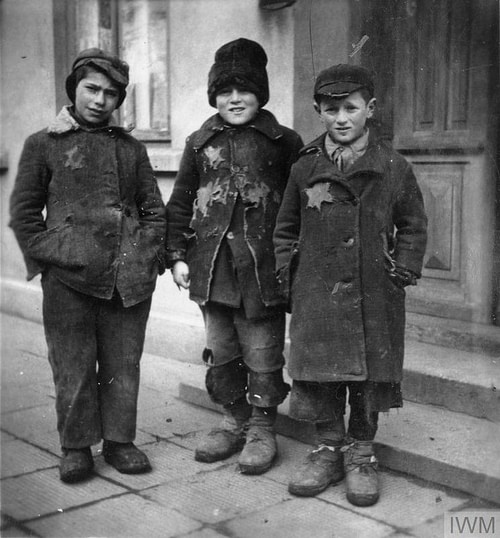
Hitler's Personal Views
Hitler's anti-Semitic views were not simply a political cloak of convenience but his real opinion, and that of many other members of the Nazi Party at every level. August Kubizek, a friend of Hitler's when he was in his twenties and living in Vienna recorded: "His accumulated hatred of all forces which threatened the Germans was mainly concentrated upon the Jews, who played a leading role in Vienna." (McDonough, 110). Hitler seemed most angry about how many Jewish people lived in Vienna, depriving it, he said, of its "Germanic" character. Although Hitler did, in fact, have Jewish acquaintances and he even spent musical evenings in certain Jewish homes in Vienna, his personal views were made clear in a letter he wrote to another friend in 1919:
The facts are these: First, Jewry is absolutely a race and not a religious association…Their dance around the golden calf is becoming a merciless struggle for all those possessions we prize most highly on earth…In his [the Jew's] effects and consequences he is like a racial tuberculosis of the nations.
(McDonough, 128)
Hitler, then, was identifying people of a certain religion as actually belonging to a specific race. Hitler, with help from his propaganda specialist Josef Goebbels (1897-1945), presented to the German people that Jews were enemy number one. Hitler repeatedly spoke of how – in his view – Jews had been behind Germany's defeat in WWI. Jews, said Hitler, had repeatedly called for a premature end to the war and so diminished the will of the German population to fight. Further, Hitler believed that Jews had had a stranglehold on the economy, which had badly affected the war effort. For Hitler, Jews were now part of an international conspiracy to control the economy and wealth of post-war Germany, preventing ordinary people from prospering. The Nazis then blended this idea of a common enemy with a pseudo-scientific and inconsistent race theory, giving them a seemingly reasoned and academic justification for their treatment of Jewish people.
Nazi Race Theory
The racial theorist of the Nazi party was Alfred Rosenberg (1893-1946), who propounded both anti-Semitic and anti-Christian ideas. Rosenberg had studied architecture, but he became interested in racial theory through the works of such authors as Arthur de Gobineau (1816-1882) and Houston Stewart Chamberlain (1855-1927), both of whom believed in a Nordic super race, to which all other races were regarded as inferior. Rosenberg wrote his first book in 1920, The Track of the Jews through the Ages, in which he presented his rather inconsistent and indigestible ideas that Jews were behind both capitalism and Bolshevism and were intent on destroying culture and morality wherever they lived.
Rosenberg was a conspiracy theorist since his ideas were often based on fake research presented by others. Jews were not, as Rosenberg presented, benefitting from the 1917 Russian Revolution but were one of its greatest victims via a series of vicious pogroms. Rosenberg's ideas were often based, too, on inaccurate statistics, such as how many Soviet Commissars were Jewish, and on misinformation, for example, that US foreign aid was only ever given to Jews when this was not actually the case. Rosenberg convinced himself and his fellow Nazis that Jews were working together in an international conspiracy to take over the world.
The Nazi Party's programme of 1920 included a specific clause, number 4, concerning Jewish people:
None but members of the nation may be citizens of the state. None but those of German blood, whatever their creed, may be members of the nation. No Jew therefore may be a member of the nation.
(McDonough, 111)
By 1923, Rosenberg was editor of the Nazi newspaper, Völkischer Beobachter, a publication packed with Nazi propaganda, stoking up hatred of Jewish people, Communists, and anyone else the Nazis did not like. Rosenberg's "continuing conspiracy tales fueled the vicious streak in National Socialist antisemitism" (Gellately, 51).
After Hitler's failed Beer Hall Putsch, the attempted coup of November 1923, he was sent to prison but he used the time to write a book, Mein Kampf or 'My Struggle'. In this work, and probably thanks to daily visits from Rosenberg, Hitler incorporated Rosenberg's anti-Semitic ideas into a theory where German Jews were identified as enemies of the state and the main reason Germany was not fulfilling its potential. Hitler suggested this potential would only be realised if the country were governed by pure-blooded 'Aryan' Germans, a rather vague term the Nazis used to refer generally to non-Jews but often used primarily to refer to White groups such as the Nordic peoples.
Further, Hitler latched onto the conspiracy theory that the Jews were intent on world domination. By equating both revolutionary communists and grasping capitalists with Jews, Hitler could present the German people with the idea that both the USSR and countries like Britain, France, and the United States were intent on attacking Germany. Germany must defend itself. Germany must rid itself of the enemies within, Hitler said. In addition, Hitler very much wanted Germany to be a militaristic state since that would greatly help reduce unemployment and give Germany the means to invade other countries and benefit from their resources. It would also help the Nazis control the entire population. Accordingly, Hitler presented the idea that war was essential to Germany's survival.
An idea that went in tandem with the race theory was that the 'master race' (Herrenrasse) must be continuously tested and strengthened through a never-ending struggle with inferior races like Jewish people and Slavic people (another group the Nazis hated). This idea of a constant struggle between races was influenced by social Darwinism, the concept that applied the laws of nature and the survival of the fittest to human society. For Hitler, in order for his master race to thrive, more land and resources would be needed and so the expansion of Germany, particularly in the east, was justified. This expansion to find Lebensraum ('living space') would bring the 'Aryans' in further conflict with Slavs and Jews.
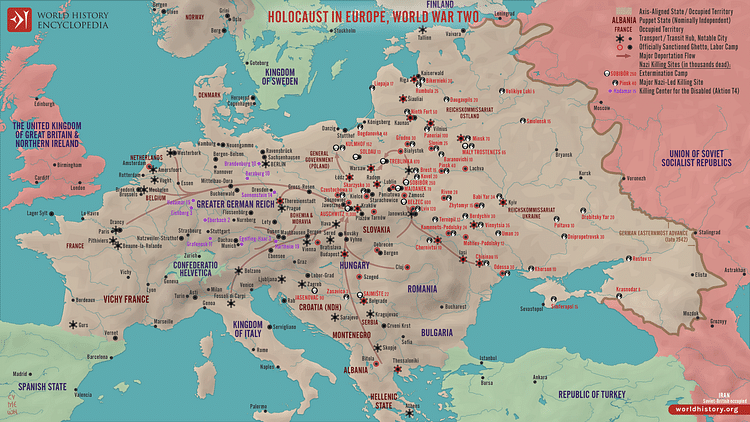
Rosenberg published his Myth of the Twentieth Century in 1930, which showed that he and Hitler were creating the same race-based blueprint for Germany's future, a plan with Jewish people as the number one target. In his book, Rosenberg blended a mishmash of pseudo-science and the history of ancient and modern civilizations, real or imagined, to create a theory that rejected both democratic and liberal values, replacing them with a dictatorial system where a race of 'supermen' ruled over the inferior races. The 'supermen' were the 'Aryans', amongst whom Rosenberg considered the elite 'master race' as being the Germanic 'Aryans'. In contrast, Jewish people and Black people were put at the very bottom of Rosenberg's social scale.
Nazi race theory helped to increase the popularity of the Nazi Party in elections for the German parliament through the 1920s by tapping into a common streak of anti-Semitism. However, many other parties were also anti-Semitic, and so this was far from being the only appeal of the NSDAP. As the noted Holocaust scholar D. Cesarini notes, "the Nazi Party did not come to power because of anti-Semitism" (p xxx). The question "How did Hitler rise to power?" has many answers. Other points of appeal included, for example, promises to increase employment and restore German pride after the humiliation of WWI and the Treaty of Versailles.
When Hitler was invited to become chancellor and he established a dictatorship in 1933, the Nazis' anti-Semitisim really came to the foreground of their politics. The Nazi race theory was applied to justify practical actions like confiscating Jewish wealth and providing an excuse for military conquest. As Cesarini puts it, Nazi "policy was perpetually informed by the fantasy of the 'Jewish enemy'" (p xxxi). For some historians, Nazi race theory "can be seen as a mere propaganda gloss for a political strategy that was opportunistic or shaped by circumstance" (Dear, 608). It was not easy to speak out against Nazi race theory and its practical consequences since "ideological conformity was enforced on the population, and dissent from ideological goals was violently penalized" (Dear, 608). It is important to remember that the Nazi regime was a totalitarian one and it used ideas on race not simply to express anti-Semitism but also to control everyone, Jews and non-Jews included. Further, "racial policy gave the state license to intrude into ever more private and personal realms" (Cesarini, 56).
Hitler's 'Solutions' to the 'Jewish Question'
Having identified that Jewish people were a 'problem' and had to be removed from German territory, Hitler set about carrying out a series of 'solutions'. The first solution was to disrupt the daily lives of Jews, such as moving them from villages to larger towns and cities. Other solutions soon came along, each one escalating the terror. Nazi propaganda in print, radio, and film, persistently tried to justify this terror. It must be said, too, that for some non-Jews there was an opportunity to acquire the wealth and customers of Jewish businesses, which were all eventually closed down. In the early years of Nazi rule, there were public voices of dissent, but these proved ineffective in stopping the Nazi dictatorship in pursuing its goals. Those who did speak out were often investigated by the Gestapo, the Nazi secret police, which could lead to beatings, prison, or worse.

The various 'solutions' the Nazis initiated to solve their Jewish 'problem' included encouraging emigration, removing citizen rights, intimidation, beatings, destruction of property, and rounding up into closed-off ghettos. In order to know who these measures were to be applied to the Nuremberg Laws were passed in 1935, which identified who exactly was a Jew from the Nazi point of view: essentially anyone with three or more Jewish grandparents. This meant that hundreds of thousands of people who did not consider themselves Jewish were nevertheless classified as being a Jew by the Nazi regime. The Nazis wanted to keep the blood of the Aryans 'pure' and so the Nuremberg Laws included clauses prohibiting sexual relations between Jews and non-Jews. The idea of 'impure' blood helped the Nazis "create the image of the German Jew as different, alien, and dangerous." (Dear, 285).
Despite the difficulties imposed on Jews, Hitler was frustrated to find that none of his 'solutions' succeeded in emptying German territory of his number one enemy. Indeed, as Germany expanded its borders from 1938 with the Anschluss with Austria, Hitler's occupation of Czechoslovakia, and the invasion of Poland in 1939, Hitler found himself with millions more Jews under Nazi rule.
Hitler settled on what he called the 'Final Solution', a secret plan to kill millions of Jews (and others) through forced labour and in extermination camps. Jews were also killed by roaming special SS killing squads, the Einsatzgruppen. The killing only stopped in the spring of 1945. Hitler committed suicide in April after writing a final "political testament" where he was still madly blaming Jews for starting the war. Germany collapsed, and the Allies claimed victory in Europe in May 1945. A measure of justice was achieved in the post-war Nuremberg trials where men like Rosenberg were found guilty of crimes against humanity and hanged. Other Nazi war criminals were subsequently brought to justice.
The Holocaust involved the murder of 6 million Jews across occupied Europe. The United Nations designated 27 January as Holocaust Remembrance Day, the day that the Nazi Auschwitz concentration and extermination camp was liberated.






